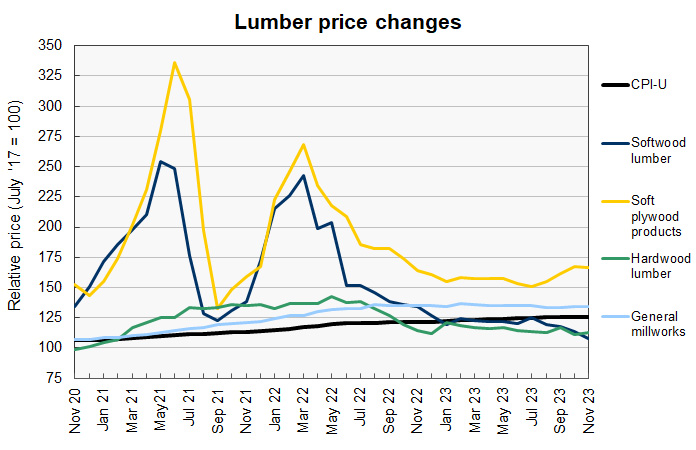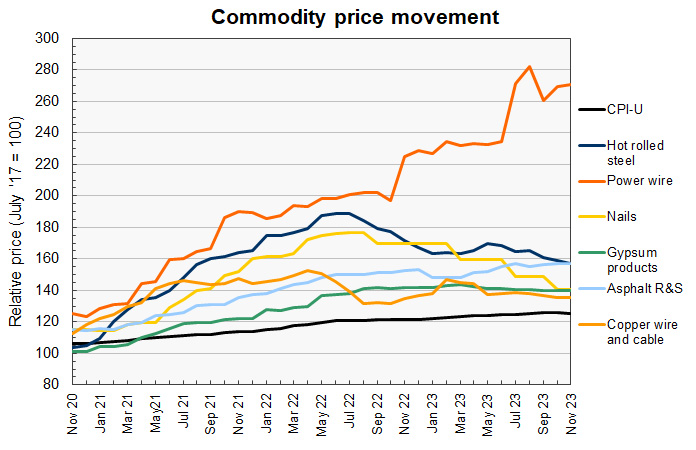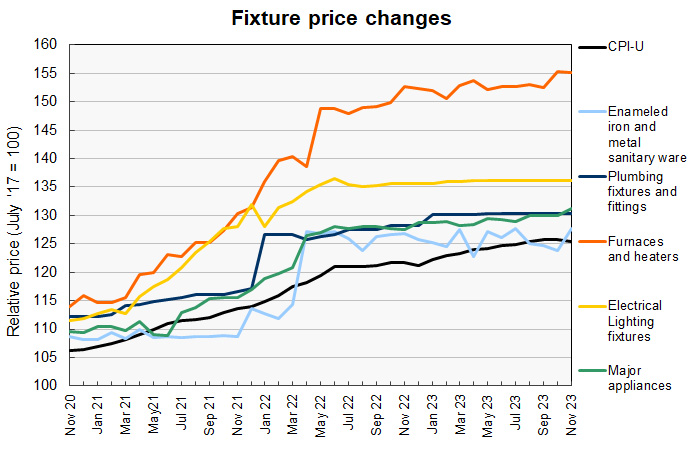The producer price index (PPI) report from the Bureau of Labor Statistics (BLS) stated that construction materials prices were up 0.2 percent month-over-month in November on a seasonally adjusted basis. However, last month’s price change was revised downward from a 0.1 percentage point increase to no change. The index of components and materials for construction was up 0.8 percent from its year-earlier level.
Overall prices for processed goods for intermediate demand were unchanged for the month. A rise in the prices of processed fuels and lubricants was offset by a fall in the prices for materials for manufacturing. The processed goods for intermediate demand index was 4.1 percent lower than its year-earlier level.
For reference, the changes in these indices compare with a 3.1 percent rise in the all-items consumer price index (CPI-U) for the 12 months ending in November. The seasonally adjusted November CPI-U was down 0.1 percentage point from October’s level. Energy prices were down 2.3 percent for the month and were down 5.4 percent year-over-year. The shelter portion of the CPI-U was up 0.4 percent for the month and was 6.5 percent higher than its year-ago level. Rent of primary residence was up 0.5 percent for the month and 6.9 percent for the year.
Yield Pro compiled the BLS reported changes for our standard list of construction materials prices. These are prices of materials which directly impact the cost of constructing an apartment building. The first two right hand columns of the table provide the percent change in the price of the commodity from a year earlier (12 Mo PC Change) and the percent change in price from October (1 Mo PC Change). If no price data is available for a given commodity, the change is listed as N/A.
The pre-COVID column lists the change in the current construction materials prices relative to the average of prices from December 2019 through February 2020, before the pandemic impacted the economy. This may give a truer idea of the magnitude of the recent price increases for materials, such as lumber, whose prices were already rising sharply last year, than does the 12 Mo PC Change column.
| Commodity | 12 Mo PC Change | 1 Mo PC Change | Pre-covid Change |
| Softwood lumber | (19.7) | (5.1) | 7.8 |
| Hardwood lumber | (1.4) | 1.4 | 23.5 |
| General millworks | (0.7) | 0.1 | 28.3 |
| Soft plywood products | 1.5 | (0.4) | 80.0 |
| Hot rolled steel bars, plates and structural shapes | (8.4) | (1.1) | 51.7 |
| Copper wire and cable | 0.5 | 0.4 | 27.4 |
| Power wire and cable | 20.3 | 0.3 | 132.4 |
| Builder’s hardware | 0.8 | 0.0 | 25.5 |
| Plumbing fixtures and fittings | 1.7 | 0.0 | 17.7 |
| Enameled iron and metal sanitary ware | 0.8 | 3.2 | 21.5 |
| Furnaces and heaters | 1.6 | (0.1) | 36.6 |
| Sheet metal products | 0.0 | (0.2) | 46.0 |
| Electrical Lighting fixtures | 0.3 | (0.0) | 18.1 |
| Nails | (17.3) | (0.0) | 23.2 |
| Major appliances | 2.9 | 0.9 | 23.4 |
| Flat glass | N/A | N/A | N/A |
| Ready mix concrete | 9.4 | 0.2 | 32.6 |
| Asphalt roofing and siding | 2.8 | (0.3) | 40.4 |
| Gypsum products | (1.5) | 0.0 | 41.1 |
| Mineral wool insulation | (1.1) | (0.1) | 39.4 |
| CPI-U unadjusted | 3.1 | (0.2) | 19.0 |
The first chart, below, shows the price index history for wood products over the past 37 months. Note that the prices used by the BLS in compiling the indexes are collected on the Tuesday of the week containing the 13th day of the month. In November that would have been November 14. In the December report, the data collection date will be December 12.

The softwood lumber price index was reported to fall by 5.1 percent in November. This index is down 14 percent since July. Since 2020, the price index for softwood lumber is up significantly less than the unadjusted CPI-U.
The soft plywood price index was reported to fall 0.4 percent in November, but this was aided by an upward adjustment of 1.8 percent for the index for the month before. This is the third report in a row where there have been significant upward revisions to the plywood price index of the previous month.
Looking ahead, NASDAQ reported that the market price of lumber closed on November 14 at $529 and rose to $536 on December 12. Between those dates, prices were as low as $524 and as high as $552. Lumber prices in the futures markets also seem to signal short-term price stability. The January 2024 contract closed on December 12 at $534, while the May 2024 contract closed at $562.
The next chart, below, shows the recent history of several other construction materials prices. These are relatively simple commodities whose prices are strongly driven by those of the materials of which they are comprised.

The price index for power wire and cable was reported to rise by 0.3 percent this month but this was aided by a 2.2 percent downward revision to its price index for the month before. Still, the power wire and cable price index has by far the highest increases both year-over-year and post-COVID of any of the construction materials prices that we track.
The construction materials prices for most of the other commodities in this grouping have been trending lower lately. The exception to this is asphalt roofing and siding. Its price index now has the fifth highest post-COVID increase of the construction materials prices we track but its year-over-year increase is less than that of the unadjusted CPI-U.
Looking ahead at prices for underlying materials, MarketWatch reported that the NYSE American steel index is down from the high it reached on December 1, but is up for the month. It closed at $1,990 on November 14 and closed at $2,022 on December 12. Meanwhile, steel futures diverged with near-term contracts rising and longer-term contracts declining. The January contract closed 3.4 percent higher on December 12 than it did on November 14. However, on December 12, the May 2024 contract closed 0.6 percent lower than it did on November 14 and 19 percent lower than did the January contract. The futures market is continuing to predict that steel prices will peak early in the 2024 and then decline gradually through spring.
The price of copper closed at $3.79 per pound on December 12 up $0.11 since November 14. It had closed as high as $3.93 per pound between those dates. Its low for the period was $3.68 per pound on November 14
The price of aluminum trended lower since our last report. It closed on December 12 at $2,121, down $114 from its level on November 14. However, it had spiked as high as $2,259 in late November.
Price changes for several of the more finished goods from our sample are illustrated in the final chart, below.

There continue to be odd things happening with the data regarding many of these construction materials prices.
Now for the third month in a row, the monthly construction materials price index for enameled iron and metal sanitary ware was reported to rise, this month by 3.2 percent. However, the reported index is exactly unchanged from the preliminary value in the prior month’s report and the “rise” is entirely due to the prior month’s value being revised lower.
There are other construction materials price indexes that have been suspiciously stable recently. The index for builder’s hardware has been reported to be the exact same value since April. The index for plumbing fixtures has been reported to be the exact same value since May. The index for electrical lighting fixtures has changed only in the last two digits of a 6-digit number since June.
Just variations in data sampling from month to month would be expected to cause more variation than this.
The full current BLS report can be found here.















